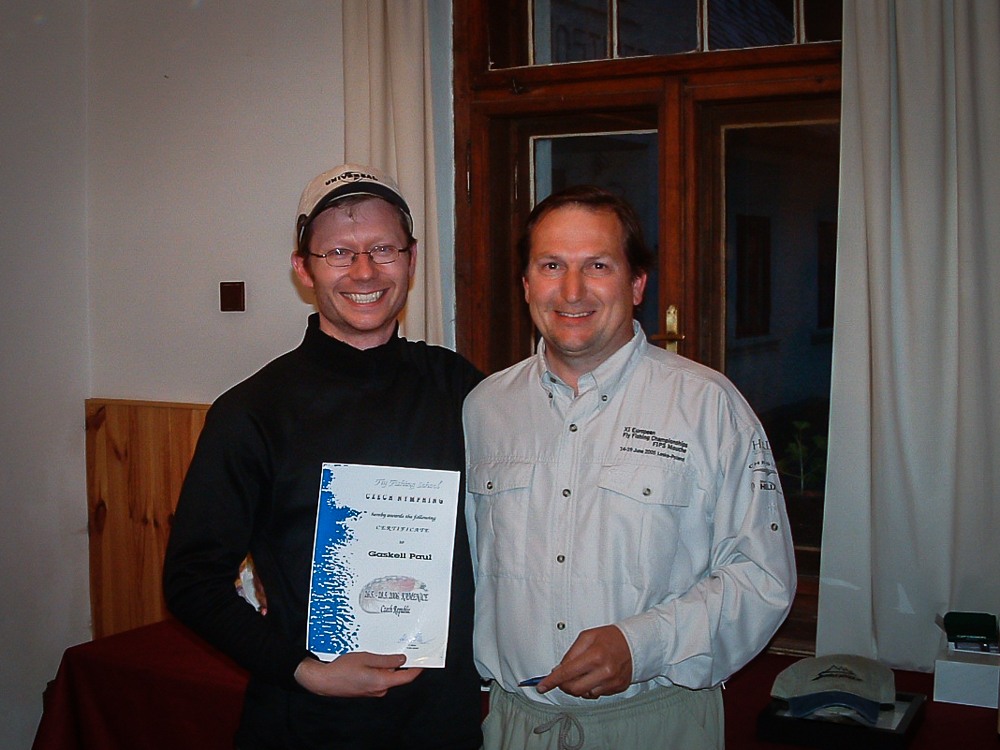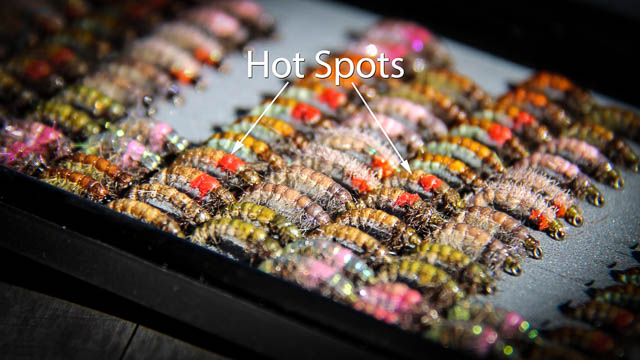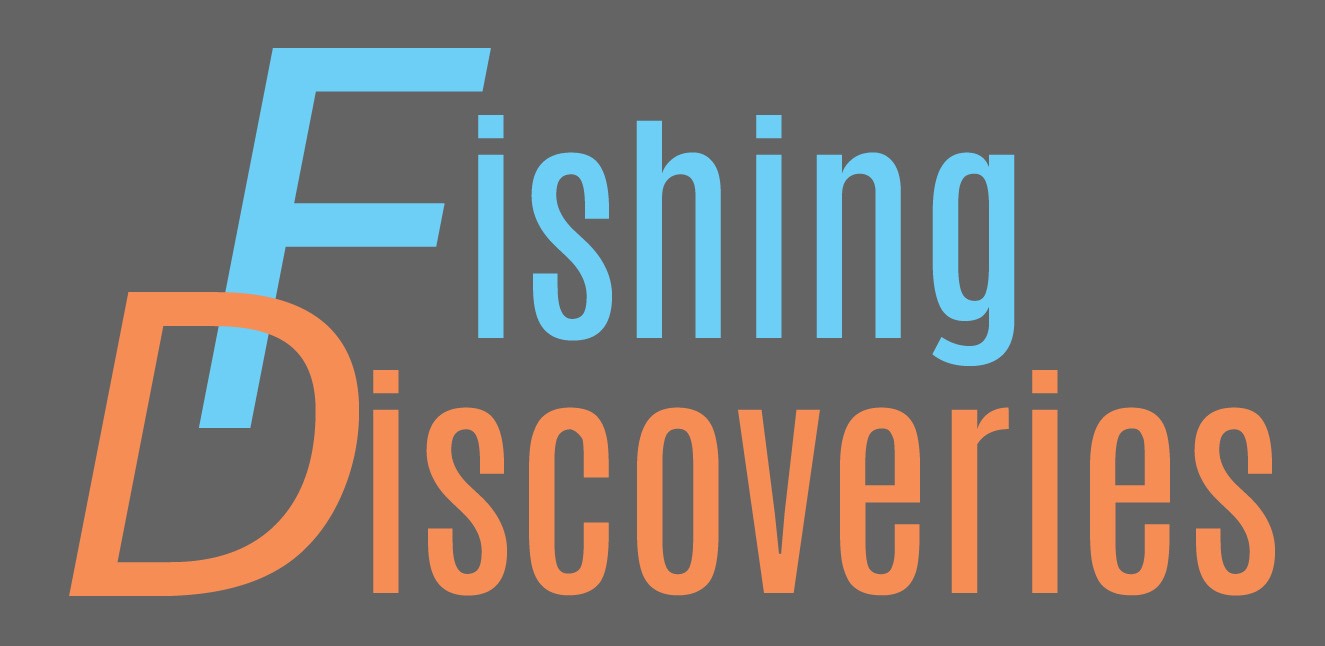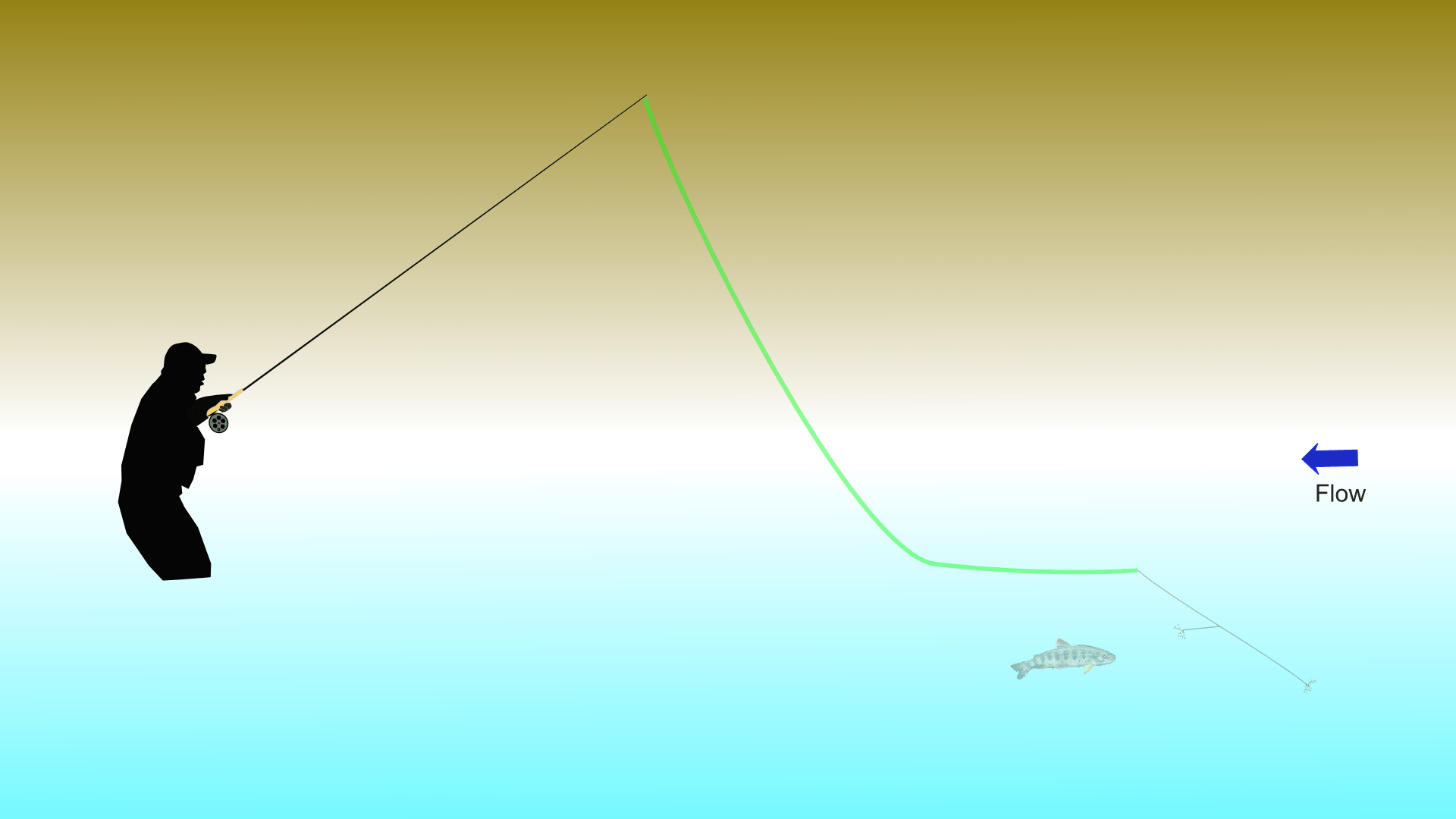Uncovering Real Czech Nymphing
(including video below)
Czech nymphing tactics burst onto the world competition scene in 1990 and smashed all alternative approaches for a decade or more. The phrase is now a familiar part of most fly fishers’ vocabulary.
This article (and the embedded videos) busts some myths and arms you with a lot of what your fishing buddies have no clue about (as well giving solid basics) such as:
What Is Czech Nymphing?

In most fly fisher’s eyes, Czech nymphing is the ultra short-range approach using quick-sinking flies which are pitched upstream and then tracked directly under the rod tip - as in the first video clip, below:
That style was developed by Czech and Polish anglers from the early 1980s (often to catch fish to eat from rivers where bait fishing was not allowed/practical) and is certainly part of the answer. You can compare the above video to our short-line Polish Nymphing breakdown.
You can also see exactly how it fits into the "Euro Nymphing" family as part of my 2020 Nymphing Bible.
Both Czech and Polish Methods have a strong association with caddis-grub shaped nymph patterns, tied over a lead wire underbody. Today, many anglers also use tungsten bead-head flies.
But it is actually much more diverse than that…
Trusted Information:
A lot of this article draws on my experiences with Czech World Fly Fishing Team coach. captain and manager Jiri Klima.
Jiri was dubbed “The River God” by Charles Jardine after sharing the river with him for a few hours.
I’m also grateful for the coaching I’ve received from Jan Siman (Gold-medal winning team member in that famous 1990 World Championships) and many other people – including John Tyzack and Stuart Crofts from the UK (Stuart in particular has relayed so many tales of his experiences with legendary Czech anglers such as Tomáš Starýchfojtů - who you'll see on the cover of Karel Krivanec's book "Czech Nymph and Other Related Fly FIshing Methods)
Huge thanks also to my friend Robert Borrenbergs from Holland. Robert has allowed me to use his footage shot during the Jiri Klima Czech Nymphing Masterclass (below) - which I attended in 2006 (plus clips from 2007 when my friend Brian went along).

Genuine Czech nymph from the personal fly box of a Czech World Team competitor in the 2000 World Championships (gifted to Stuart Crofts)
Nowadays Robert has passed the running of these events on to Karel Krivanec (author of probably the most famous book on Czech Nymphing) and Milan Hladik (https://www.milanhladik.cz). Check out Milan’s site if you’re interested in attending an event in its updated format.
I still proudly keep my certificate from Jiri, awarded in a lovely guest house on the banks of the Kamenice River, Bohemia (Pension Rusalka) from Jiri's Czech Nymphing Masterclass in 2006:

"Jiri and Me" - OK, you might smirk and roll your eyes but this is a lovely memory for me.
A bit of fun, for sure, but what I added to my nymphing arsenal over that residential course in Northern Bohemia was absolute gold-dust. I can now share at least some of those secrets with you…Here's a lightening fast impression of what the masterclass was like back in 2006 when I attended:
Jiri Klima’s Long-Line Upstream Czech Nymphing
Close your eyes and imagine pretty much the complete opposite of the picture most anglers would draw when asked to do a cartoon of “Czech Nymphing”. That’s probably not a million miles off Jiri’s long-line tactics. In fact, it’s a lot closer to the diagram I drew for classic upstream wet fly fishing:
Jiri developed this style with a relatively short rod (typically around 8ft) and very light fly line (ideally AFTM #2, double taper floating line). I’ll be working from my handwritten masterclass notes to create clear video and written breakdowns of his specific leader construction and applied techniques – so watch out for our various nymphing products and publications in future.
Here he is, captured on Robert Borrenberg’s home video camera in 2007, demonstrating the method:
The reason Jiri likes the fly line/short tippet rig so much is that it is universal – it works on small/shallow/spooky rivers as well as deeper rivers where you can approach the fish closely without spooking them.
This rig can – and is – fished short. However, it is also designed to create separation between the angler and the fish for shallower/spookier river fishing situations. In fact – the exact same challenges that French Nymphing was designed to overcome.
If you're finding these demos useful, you're likely to get a lot out of our free email tuition & subscriber offers:
Jiri’s Long-Line Downstream Nymphing
It is only looking back (and with almost 15 years additional experience) that I can start to appreciate what Jiri was showing us with his downstream approach.
I’d say that, without our 5 years of trips to Japan, I probably still wouldn’t have connected the dots by now.
This, in fact, is one of the themes we’ll hammer home over and over again on Fishing Discoveries:
The bigger range of fishing styles you experience – the better you get at your chosen specialities.
Although beyond the scope of this article to explore completely, downstream presentations offer a greater efficiency for searching featureless water – as well as more control of the drift in fast water. There is also an advantage in having fish see your fly before any other part of your rig.
Here’s Jiri demonstrating in fast, clear water – resulting in the capture of a little wild trout:
On particular days, the downstream approach is also extremely effective for grayling. Anglers are often amazed that it’s possible to catch grayling from fast water like this. Jiri is equally happy to use this presentation in slower water as well.
Karel Krivanec’s book contains descriptions of Jiri’s style of Czech nymphing – as well as some very interesting descriptions of Milan Janus’ “wetfly” style of nymphing too. It is certainly worth getting hold of a copy if you are able to.
Fly Tying for Czech nymphing
There is a long line of “prototypical” nymphs over the course of Czech nymphing’s development (including some extremely simple dubbed bodies – and not much else). Among some of the more interesting examples are the nymphs with their “shellback” made from soaked onion skin. I remember years ago Howard Croston showing me some beautiful ones he had obtained – I think – from Poland (Howard was demonstrating Czech nymphing at the Chatsworth Angling Fair on the River Derwent in Derbyshire, England).
Other inventive materials for shellbacks include salami skin – so here is a nymph tied simply with hare’s fur (some soft cream fur from the mask for the abdomen and some spiky/dyed olive fur for the thorax), fishing line rib and salami skin shellback:

Salami-skin Shellback, 6lb mono rib, hare's fur dubbing: Oldschool Czech Nymph that I re-created (it works like crazy)
In this early recipe, you can see the blueprint and the character for the flies that most people now recognise as typical Czech nymph design (see notes on "Bobeš" below).
Here is a peak into the flybox of Jan Siman to see some examples of the modern nymphs descended from those patterns. There is an extensive selection of flies, materials and hooks on Jan’s site at https://shop.siman.cz

Jiri Klima tying a “Reverse” Czech Nymph
There are many ways you can combine even the few materials that go into a Czech nymph. Two great tricks that I learned from Jiri (and use extensively to this day) are his dubbing technique and the “Reverse” style of tying in a shellback. Watch also (below) how he creates the dubbing “spindle” as he takes the material out of the packet. Notice that he traps the tip of that spindle under a thread wrap to prevent it spinning around the tying silk:
Below is a higher definition photo of a fly tied in the Bobeš (pronounced bobesh) style that is typical of many Czech nymphs. This pattern happens to have a tinsel under-rib and mono over-rib - although not all Bobeš patterns have that. The fly pictured was a gift from a Czech World Team member's personal collection to Stuart Crofts during the 2000 World Championships held in Czech Republic (now "Czechia").
The barb means that this would not be used in competition - but was from the competitor's personal fishing fly box (possibly to catch fish to eat from time to time).

Klima Products “Micro nymphs”
I should make it clear that we make no financial gains by featuring Jiri’s products or the Czech Nymphing Masterclass. However, it is important to give credit to our source of this information (and the achievements of the Czech Fly Fishing Team under Jiri’s management).
Jiri’s tying style is entirely geared around creating effective fishing tools. He ties quickly and creates impressionistic, “buggy” flies that all have specific functional properties. Whether it is a trigger point hot-spot, where and how the hook is weighted or some other performance factor – the only approval he cares about is from the fish!
Because development never stops, it is really interesting to see other lines of experimentation that he has included in his fishing. One thing that I’m surprised hasn’t had more attention is the micronymph pre-weighted/painted jungle cock thorax design. Here are two simple and effective patterns that Jiri demonstrated during my trip:

Tan body and copper rib micronymph

Olive body and yellow wire rib micronymph
Although the Klima products site isn’t reachable at the moment, the micronymph hooks are available from several suppliers - e.g. https://www.czechnymph.com/en/fly-tying-hook-jiri-klima-drop-leaded-jc-orange
Nymph Selection from my Box
Here’s a selection of flies that I literally pulled from my nymphing box to photograph. Some of them are lovely mementos of the masterclass, tied by Jiri Klima himself. Others I tied using lessons and inspiration from Czechia. They cover a wide span of sizes and weights – as well as colour schemes from drab to hi-viz. I love the way that our fly boxes are a kind of living diary of fishing days and friends...

My tying of a pattern demonstrated by Jiri at the 2006 CNM

A small (size 16) variant I came up with that has worked really well

My soft pink shellback, pink/tan and pearly pink body/copper-wire rib nymph

UV/violet, pearl shellback and hot head variant by Alex Jardine (and friends)

Jiri Klima peacock body/yellow tag/straight-body nymph tied for the CNM

Jiri Klima fuzzy/straight-body tag nymph he tied for the CNM

Jiri Klima nymph/pin-fry bead-head with pearl flash-back tied for the CNM

My Pink marabou hot-spot/straggly nymph with mono rib

A variant I tied showing the tinsel rib (under the shellback) paired with the mono rib to give segmentation over the shellback. This nymph is conspicuous while also featuring natural olive colours (both noticeable and edible!)

Bands of strong, contrasting colours in a skinny but scruffy/mobile pattern I tied as a "change" fly for fish that had seen lots of standard flies
Little-known Czech Nymphing Secrets Recap:
From this article you can:
Remember to sign up for more detailed "how to" email tutorials here if you want to learn more:
So, what do you think? Are the tactics, flies and ethos of Czech nymphing exactly as you thought they would be?
Let me know your opinions in the comments regarding information I've put into this article. I'd be particularly keen to hear if you agree or disagree with my assessment.
Finally, please do click the social share buttons and/or send the link to this article to your friends - because it really does help us to help you 🙂
Paul



What exactly makes this Czech Nymphing? I see that Jiri has fly line on the water, and watches the tip of it to detect strikes. That is how I learned to fish nymphs in the United States in 1976.
In his book TROUT TACTICS, published in the 1970s or early 1980s, Joe Humphreys of Pennsylvania describes this method of nymph fishing. In that book Joe also describes his method of fishing nymphs and streamers with all monofilament; no fly line. Joe also recommends tying nymphs with lead wire, so that is not unique to Czech nymphing either, nor is tight line nymphing with no fly line on the water. Joe wrote about that as well.
Are these methods named after countries because the fly fishing teams from those countries were the first to use them in competition?
It’s a combination of a few things – first of all it’s probably worth pointing out that people fishing nymphs in Czechia back in the day most likely just called it “nymphing” – and there was certainly a lot of rivalry with the tactics developed in Poland from the late 1970’s through early 1980’s – often focussed around short-line tactics; so much so that you’ll find a lot of people who are reluctant to call anything Czech Nymphing (especially advocates of Polish Nymphing…).
When competitions start to be won by particular teams adopting a broadly connected style of fishing, then the victors often get to name the method (or if the winning team themselves don’t then teams competing against them would naturally refer to the methods used by each team according to the country they were representing).
The reasons the methods described in this article are flagged up as an overlooked part of the Czech Nymphing family include the fact that this was one of the main styles taught during a residential course run by Jiri Klima (long time coach of the Czech World Team) and the course was called “Czech Nymphing with Jiri Klima”.
In the book “Czech Nymphing and related methods” I think it also refers to this style as Jiri’s long line style – and some of the characteristics that are significant include the very short leader/tippet (to increase “contact” and bite sensitivity) as well as the use of AFTM #2 fly line and an 8’3″ rod rated for that line also. Those small details are the things that, when combined, add up to big differences in results – and why it is useful to not just say “This is just high sticking” or “This is just upstream nymphing”.
Jiri also talked about the “short nymph” and even “tippet nymphing” as other “Czech Nymphing” methods…and as an aside the current evolutions of “tippet nymphing” are usually labelled “Spanish Nymphing” – even though it is fairly widely accepted that this current refinement of that style comes largely from France.
As mentioned before, if a particular nation happens to win several competitions using a set of skills, it is common and natural for that national label to be used as a short-hand identifier for the overall method (even if it was invented elsewhere).
So, in the messy and imperfect and ever-shifting world of “hot” competition methods – these labels tend to be an inexact science. They also morph depending on how and where stories of these methods are shared.
I hope that makes at least some sense?
Paul
I’ve started reading through your online material and it’s made me realise how much I either just didn’t know or certainly could improve on. I particularly like the way you have outlined the history of various methods and the practical ways these can be utilised. Superb!
Tim – thank you for such a kind comment. It seems like you are one of the rare breed of folks who likes uncovering new info (rather than running away from it ha ha). I hope that all the stuff we’re working on is helpful and interesting to you.
While I was away on vacation recently I took the decision to go fully ahead with a nymph fishing book project that I’ve been on the fence about. The time away let me work on that in the evenings without the distractions of dozens of other jobs. I really hope you enjoy the end result of that too.
Paul
It’s about time you got a book out
Super kind of you to say William – I have been piecing some stuff together over the last couple of years; but I think it is one of the three things that are “next in line” on the production line. No rest for the wicked and all that.
Cheers,
Paul